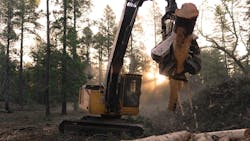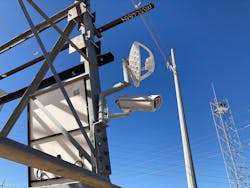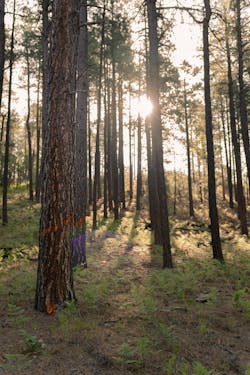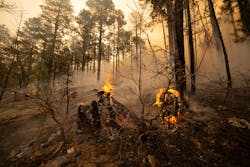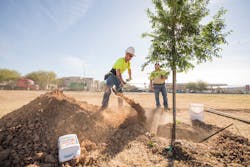Why Salt River Project Invests in Forest Partnerships
About 120 miles (193 km) of Salt River Project’s (SRP’s) high-voltage power lines are located on forest service land located in northeastern Arizona. The lines deliver power to about 1.1 million people in the Phoenix metropolitan area. In addition, SRP provides water to about 2.5 million people in the greater Phoenix area.
Arizona’s forested lands have been hit by devastating wildfires over the last decade and are primed for more infernos like those that have impacted California and Colorado. Many forested lands in northern Arizona have thousands of trees per acre, which can fuel large wildfires that are uncontrollable with catastrophic impacts.
Entire State Impacted
Wildfires not only devastate natural ecosystems, recreational areas and local communities, they also degrade water quality and resiliency and can interrupt power delivery if transmission lines are impacted.
This is concerning because residents of the Phoenix metro area live in a desert environment, where reliable water and power are crucial. Furthermore, a recent study by the Electric Power Research Institute found that costs associated with a catastrophic fire can run up to hundreds of millions of dollars.
Forest 500 Project
To ensure reliable power for its customers, every five years, SRP crews conduct the Forest 500 project, which identifies trees and other vegetation that pose a risk to the utility’s power system. SRP hires contractors to help strategically remove plants, parts of trees and other vegetation growing close to transmission lines. The effort is done in coordination with the Bureau of Land Management as well as state and private land between the forests where brush must be cleared.
During wildfire season, if tall vegetation is not removed, low vegetation can ignite the taller vegetation, forming fuel ladders that bring flames closer to the taller trees and overhead power lines. SRP has been clearing hazardous vegetation since 1996 to improve the health of forests as well as power reliability in the greater Phoenix area.
Smoke Detector Pilot Project
In 2023, SRP also is piloting a Smoke Detector project that acts as an early-warning system for wildfires that occur near the utility’s transmission line towers in the Tonto and Apache-Sitgreaves national forests. The project uses cutting-edge camera and smoke detector technology to capture physical changes on the utility’s 500-kV transmission towers that transmit energy to SRP’s customers from power plants located in eastern Arizona.
Through artificial intelligence, the cameras learn the surrounding environment, report changes and provide alerts when identifying smoke from wildfires or changes to structures. Cameras also can alert SRP to issues such as downed lines, downed towers and damaged equipment. The cameras are planned to be up and running by May 2023, just in time for forest fire season.
“Today, if a fire impacts our lines, we may not know until we get an alert that something has interrupted the delivery of power. Our crews could be up to 200 miles [322 km] away and have no visuals to determine what is happening,” said Floyd Hardin, SRP fire management officer. “With this tool, we have the potential to see images nearly in real time and can determine our next steps quickly and efficiently.”
Strategic Thinning
For water resiliency and reliability, SRP also is partnering with the U.S. Forest Service, Arizona cities, towns, counties and other organizations to help prevent the devastating impacts from wildfires by strategically removing small trees that will enable healthier trees to thrive. Preventive strategic thinning will not only improve the health of forests and watersheds but also reduce the need to reforest large sections of our forests.
Thinning the forest not only helps with power and water reliability, it also offers the added benefit of providing rural jobs, increasing infrastructure and equipment investments, and helping to drive rural economic development opportunities.
As the Phoenix metro area continues to grow and thrive, it is critical for SRP to provide sustainable and reliable power and water. A lot can be learned from the wildfires that have ravaged Arizona, and SRP is acting on those lessons now. With support from partners, industry and researchers, the utility is building the tools needed to reach its forest health goal.
PATTY GARCIA-LIKENS ( [email protected]) and ERICA ROELFS ([email protected]) are media relations representatives covering the subject matter areas of water and power on behalf of Salt River Project (SRP) in Arizona. SRP is a community-based, not-for-profit public power utility and the largest electricity provider in the greater Phoenix metropolitan area, serving approximately 1.1 million customers. SRP provides water to about half of the Valley’s residents, delivering more than 244 billion gallons of water (750,000 acre-feet) each year, and manages a 13,000-square-mile watershed that includes an extensive system of reservoirs, wells, canals and irrigation laterals.
About the Author
Patty Garcia-Likens
Patty Garcia-Likens is Senior Media Relations Strategist at Salt River Project.
Erica Roelfs
Erica Roelfs is Lead Media Relations Strategist at Salt River Project.
